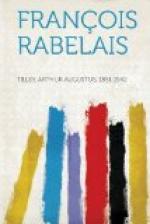|
This section contains 14,595 words (approx. 49 pages at 300 words per page) |

|
SOURCE: “The Fantasies of ‘Mad Rabelais’: Exploiting the Unreal,” in Imagining Rabelais in Renaissance England, Yale University Press, 1998, pp. 146-95.
In the excerpt below, Prescott traces the influence of Rabelais's ideas about fantasy toRenaissance writers and artists.
In a culture that is ambivalent about the mental powers that can set lovers' eyes rolling or lead a nervous nocturnal traveler to suppose a bush a bear, Rabelais's fantasy seemed variously repellent or engaging. Either way, it was rhetorically useful. Michael Drayton jokingly calls Rabelais himself mad. Nimphidia, The Court of Fayrie (1627), a mock epic about the tiny fairy knight Pigwiggen, names earlier triflers:
Olde Chaucer doth of Topas tell Mad Rablais of Pantagruell, A latter third of Dowsabell, With such poore trifles playing.(1)
Drayton plays deftly with perspective: Sir Topas encounters the giant Olyphant, and the maker of tiny pigwiggen remembers Pantagruel. And because his speedy tetrameters describe small...
|
This section contains 14,595 words (approx. 49 pages at 300 words per page) |

|


